Explore the latest news and find out what's on this month
Explore our learning offer for schools, families and community groups
Uncover the rich history of Elmbridge with our latest online exhibitions
Want to discover more about your local area?
Explore the latest news and find out what's on this month
Explore our learning offer for schools, families and community groups
Uncover the rich history of Elmbridge with our latest online exhibitions
Want to discover more about your local area?

I am an Exhibitions Volunteer at Elmbridge Museum and have been working on the Everyday Heroines online exhibition over the summer. I am currently studying for a Masters degree in Museums, Galleries and Contemporary Cultures at the University of Westminster. I am passionate about museums and how they can contribute to people’s lives through access to information and improving wellbeing. I feel that museums have a unique ability to tell important stories and spark connections and reflection. I have thoroughly enjoyed unlocking these wonderful and inspiring women’s stories and learning more about women’s history. I hope this exhibition helps you reflect on your everyday heroines and how you can be one in your own life.
Read my blog hereOur Exhibitions Volunteer, Lucie, takes you behind the scenes in our museum store. Here you can see her look for an object to photograph for our exhibition.
This video gives you a sneak peak into how we store and care for the objects in our collection.
Watch more behind the scenes videos on Elmbridge Museum's YouTube channel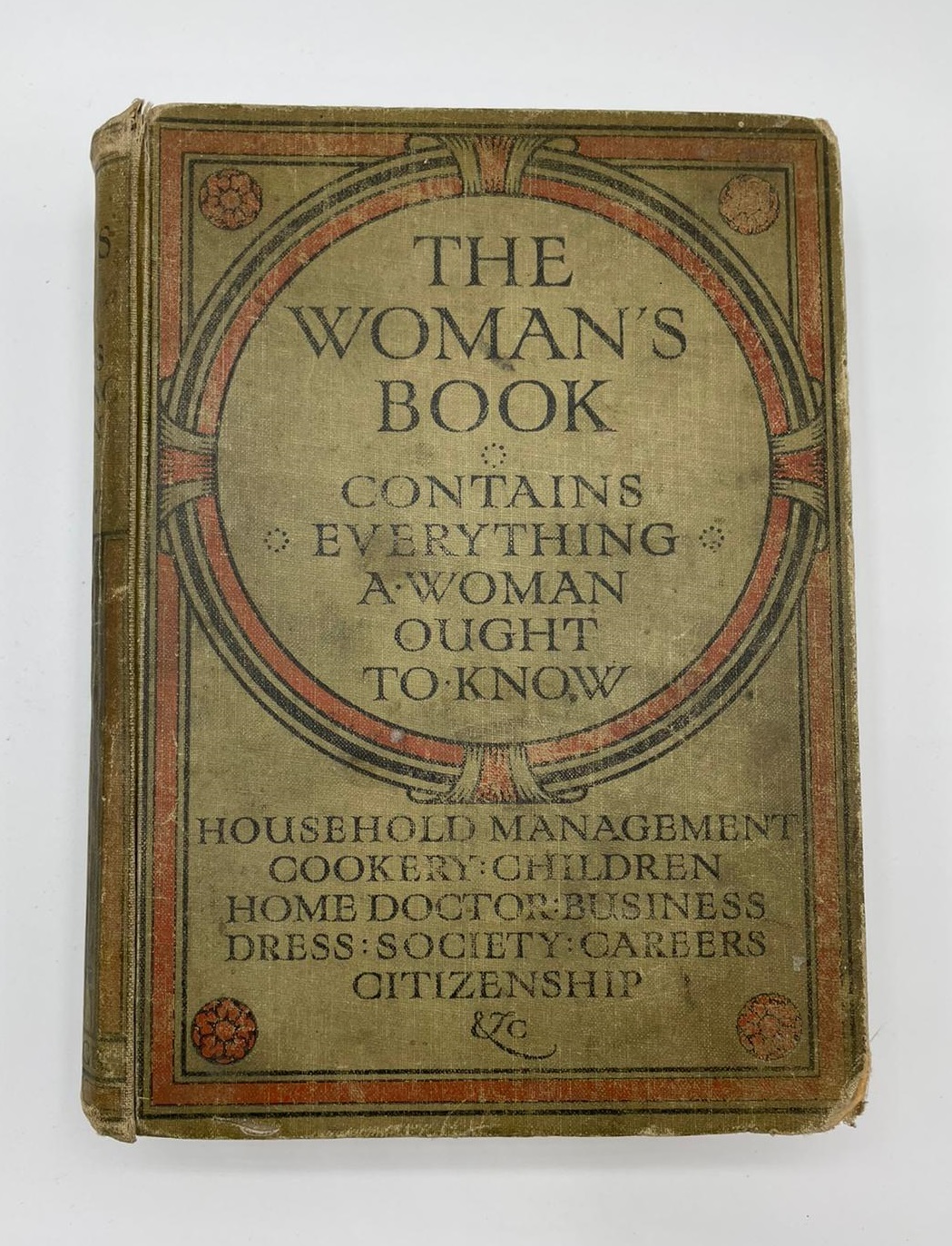 The Woman's Book. ''Contains everything a woman ought to know.'' This book contains information on household management, cookery, motherhood and careers.
The Woman's Book. ''Contains everything a woman ought to know.'' This book contains information on household management, cookery, motherhood and careers.
It was not until 1870 that the state began to provide schools in Britain. Educating children was a concern of the wealthy, with poorer children receiving rudimentary tutelage. Children from wealthy families learnt to read, write, dance, play instruments and needlework.
Boys and girls studied vastly different curriculums; girls in the 19th century learnt domestic skills which would allow them to join the domestic service or carry out the role of housewife.
‘The Woman’s Book’ was written to help women navigate their lives in the 1920s. The majority of this book provides knowledge on household management, cooking, cleaning and looking after children.
However, the latter chapters of this book speak of the range of professions that have now opened their gates for women: medicine, nursing, agriculture, literary work and business. The author even lists the Chief Medical Degrees open to women at the time and explains the level of training, costs and time implications.
Learn more about the education of girls and boys in our Young Victorians exhibition'We have noted the variety of work undertaken by women. It is a matter for congratulation that so many new spheres of usefulness have been opened for women within recent years; but we look forward to the time when capacity for work will be the only test of competence to undertake it. To have the work well done – that is the end to be aimed at, whether it be done by men or by women. It is often urged that the limited outlook and training of women in the past have left them insufficiently developed in mental capacity and judgement for certain responsible spheres of work. But it seems to us that, if the test of the educative value of work is the number of faculties it calls into play, woman’s work, even in the past – the work of the domestic woman – called forth faculties of the highest order.'
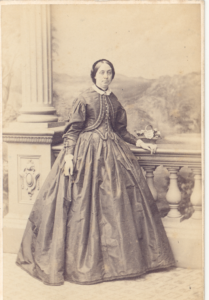
Carte de visite of Mrs Fanny Susannah Gill, c. mid- to late-1800s.
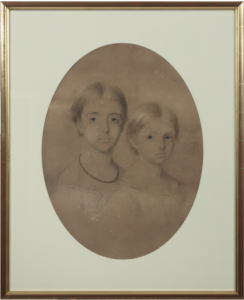
Double portrait of Frederica Fanny Gill and her sister Madeline Lucy Gill. The portrait is dated 1858.
The Gill Family were a prominent local family who lived at Apps Court in Walton on Thames in the 19th century. Fanny’s husband, Robert Gill, was a railway pioneer.
The pair had four daughters who were well educated.
Frederica was the eldest Gill daughter. She was educated to a high level and many objects in the museum’s collection support this.
Learn more about the Gill family in our object in focus post.
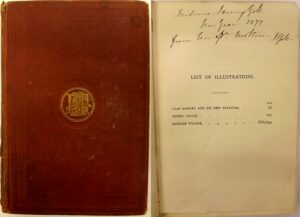
Front and inside cover of the ‘Novels of George Eliot, Vol III, Silas Marner’ belonging to Frederica Gill.
This Silas Marner book was gifted to Frederica Gill by her mother in 1877. The author of the novel was Mary Ann Evans who wrote under the pseudonym George Eliot.
This book is evidence of women in the Elmbridge borough valuing emerging literature on religion, community and destiny.
The handwritten note at the top of the inside cover reads:
‘Frederica Fanny Gill, New Year 1877, From her mother F.S. Gill.’
Read about historic female authors in our Literary Elmbridge exhibition.
'Our great grandmother Ann B. married John Gill of the Mill at Bintry a few miles distant, he died in 1774 aged 42 leaving his widow to bring up her sons... Our father remembered her with affectionate veneration, describing her as a little but dignified old lady, who wore black velvet shoes & leant on a gold headed stick, she was very pious, & her voice was often overheard by him repeating her private prayer aloud in her bedchamber.'
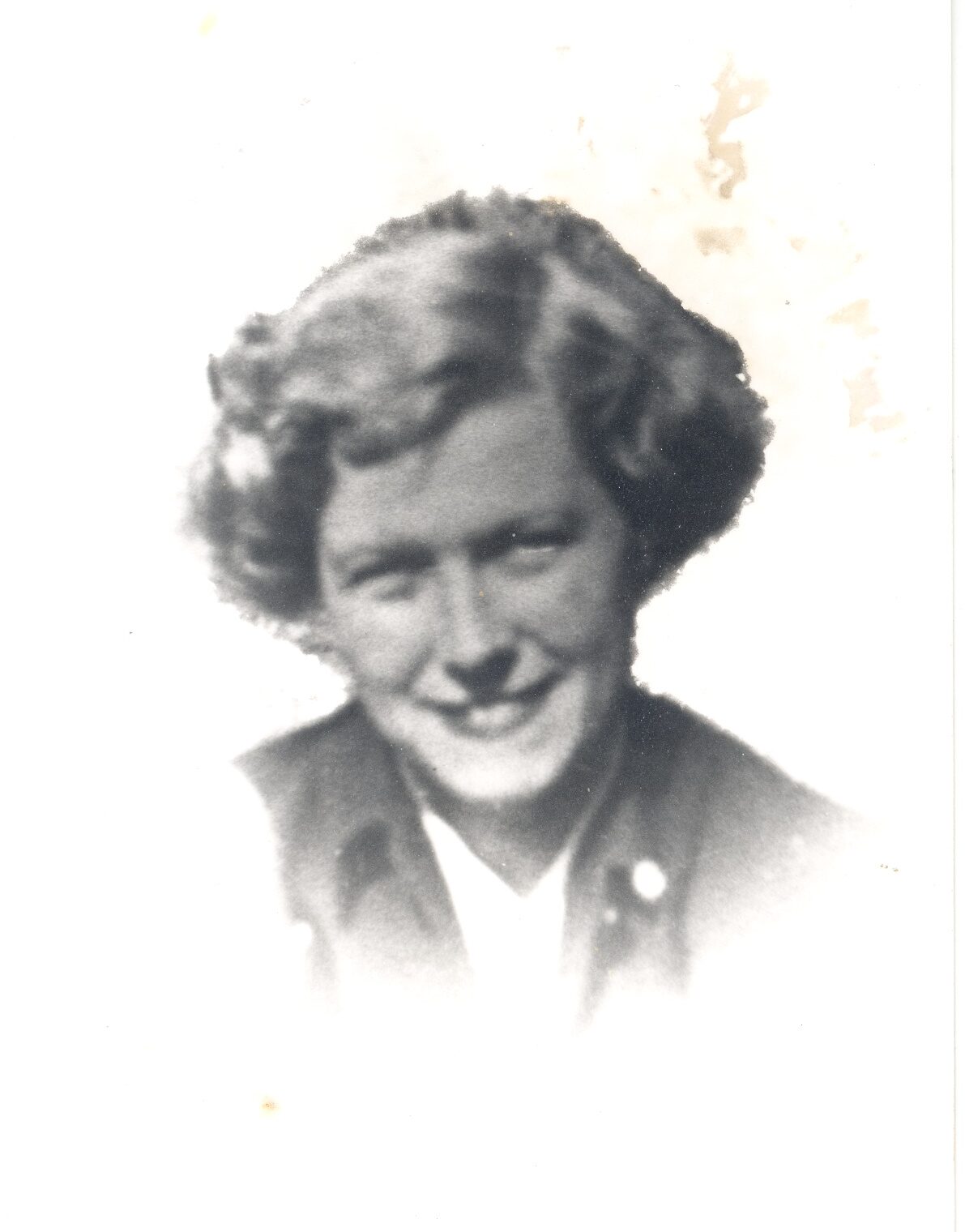 Head and shoulders photograph of Mrs Margaret Le Fevre taken in 1953.
Head and shoulders photograph of Mrs Margaret Le Fevre taken in 1953.
Born in 1917, Mrs Margaret Le Fevre taught at local schools in Virginia Water, Walton and Addlestone and then, for over twenty years from 1940, at St James’s Junior School, Weybridge. She joined the Walton and Weybridge History Society when she attended the first General Meeting on 11th April 1964 and was elected to the committee. Mrs Le Fevre put a great deal of time and effort into the creation and running of the Junior Section for over three years from October 1966.
Margaret Le Fevre dedicated her life to education during her teaching years, writing books to help children learn how to read.
In the late 1960s she began a Local History diploma course and in addition was researching for her 300 Years of Local Schools, a highly regarded work of reference which the Walton and Weybridge History Society published in 1970.
Below is a scrapbook created by Margaret in which she collated recollections of old Weybridge, collected by her pupils at St. James’ Junior School. Here we can see her passion for education and local history, much like our own museum’s values.
 British Red Cross Medals awarded to Miss Molly Jack in 1941 for First Aid, Home Nursing and three years service.
British Red Cross Medals awarded to Miss Molly Jack in 1941 for First Aid, Home Nursing and three years service.
Throughout history, women have worked for innovation and social prosperity. This is true for women in Elmbridge as well.
Many ‘everyday’ women were collectively pioneering during the First World War of 1914-18 and the Second World War of 1939-45, by performing jobs formerly considered only suitable for men, or by joining the war effort alongside men as nurses, truck drivers, radio operators and many more support roles. This is evidenced by the thousands of war medals issued to women in both conflicts. These medals were issued to Molly Jack, who owned a shop in Walton High Street and joined the British Red Cross as a nurse during the Second World War. She is just one of numerous other Elmbridge women who proved that they were just as capable as men in the conflict.
With women stepping into higher level jobs and having access to education and knowledge, it is perhaps unsurprising that they would fight for the opportunity to vote and have a say in the country they lived in and contributed to.
The women below are inspiring examples of initiative, innovation and creating social change. These women are caring and passionate about others, allowing them to advance our society in medicine, democracy and science.
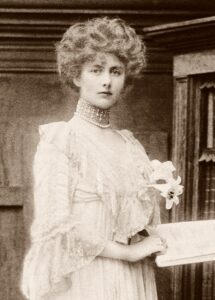
Lady Helen Vincent, by Alice Hughes (1857–1939) – Royal Collection RCIN 2809214 (working link), Public Domain, https://commons.wikimedia.org/w/index.php?curid=35542891
Helen Vincent lived at Esher Place, a magnet for London’s social, political and cultural elite.
She was vice-President for the Surrey Branch of the Red Cross and worked in hospitals in France and Italy. During the First World War, she experienced bombings, life on the front line and family bereavements. Whilst working as a nurse, she noticed the shortage of skilled anaesthetists.
She used her social connections to gain an placement in London as an observer, and then as assistant to principal anaesthetist Dr. W. Page.
Between 1916-18 she administered 1,137 anaesthesia in France and did not lose a single patient as a result of the anaesthesia. Helen dedicated herself to reducing the distress and anxiety of her patients.
Discover more about Helen Vincent on the Elmbridge Hundred website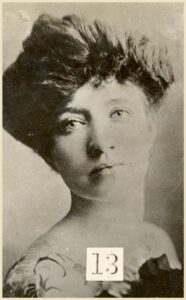
Kitty Marion c.1913 (Criminal Record Office, Public domain, via Wikimedia Commons)
Kitty Marion began supporting women by advocating for female performers against corrupt agents and fighting for better working conditions.
She joined the Women’s Social and Political Union, initially selling their newspapers in 1908.
Her most notorious act as a suffragette was burning down the grandstand at Hurst Park in 1913. This act was a protest against the British Government’s refusal to give women the vote and to commemorate Emily Wilding Davison’s death at the Epsom Derby earlier that same year.
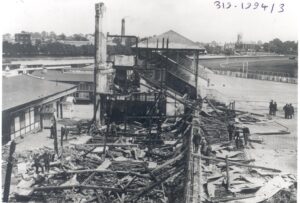
Photograph of the remains of the Hurst Park Racecourse Grandstand after the fire in June 1913.
Marion was sentenced to three years in prison and committed to a hunger strike, resulting in her being subject to extensive force-feeding.
Her experience in prison only motivated her further and she went on to fight as a birth control activist.
Explore the Hurst Park fire in our A Day at the Races online exhibition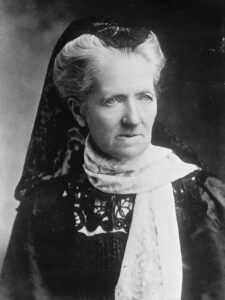
Charlotte Despard of the Women’s Freedom League c.1910-15 (Bain News Service, publisher, Public domain, via Wikimedia Commons)
Charlotte Despard lived at Courtlands, a country house in Esher, and was an iconic campaigner in the suffrage movement in Surrey.
Following the death of her husband, Charlotte became involved in charity work, running a soup kitchen, volunteering at a health clinic and organising activities for youth groups.
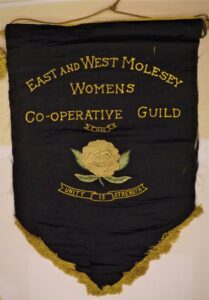
Black satin banner for the East and West Molesey Women’s Co-operative Guild in 1935.
It was in her 60s that Charlotte joined the Women’s Social and Political Union, campaigning for adult suffrage. Charlotte helped to form the Women’s Freedom League (WFL), as she did not agree with opposing all government candidates and acts of violence.
When war was declared in 1914, Charlotte and the WFL adopted a pacifist stance and continued to work in the Women’s Peace Crusade after resigning as president of the WFL. Along with Millicent Fawcett and Emmeline Pankhurst, she is widely recognised as a leader of the suffrage movement.
Learn about Elmbridge's female protesters in the Look Back in Anger exhibitionOnly a third of the female, working age population of Surrey was in employment in 1911 and half of those worked in domestic service, with others employed in traditional female spheres such as dress-making, shop keeping and laundry work.
When the First World War began, women stepped into roles they had never occupied before and a drastic shift in gender roles took place.
Men left large holes in the country’s key workforces. Government and industry bosses reluctantly decided to mobilise the country’s women. Propaganda pressured women to contribute and they responded in force.
The rush of women into manufacturing marked a significant shift from the pre-war era. In 1911, only 400 or so women in Surrey we employed in such work. By 1918 the figure had risen to over 13,000.
Discover more about local women in the First World WarBelow is the obituary for Odette from the Surrey Herald in March 1995. Following her heroic war efforts, she passionately commemorated her fellow female agents on many occasions.
‘They are all our mothers and sisters, you would not be able to either learn or play in freedom today, yes, you may not ever have been born, if such women had not stood their soft, slender bodies before your future like protective steel shields throughout the Fascist terrors.’ Odette Hallowes, 13 June 1993.

Newspaper clipping of Odette Hallowes’ obituary from The Surrey Herald, March 1995.
Read a transcription of the Surrey Herald’s 1995 obituary for Odette Hallowes here.
This badge was found in a donor's garden while he was digging for potatoes!
Learn more here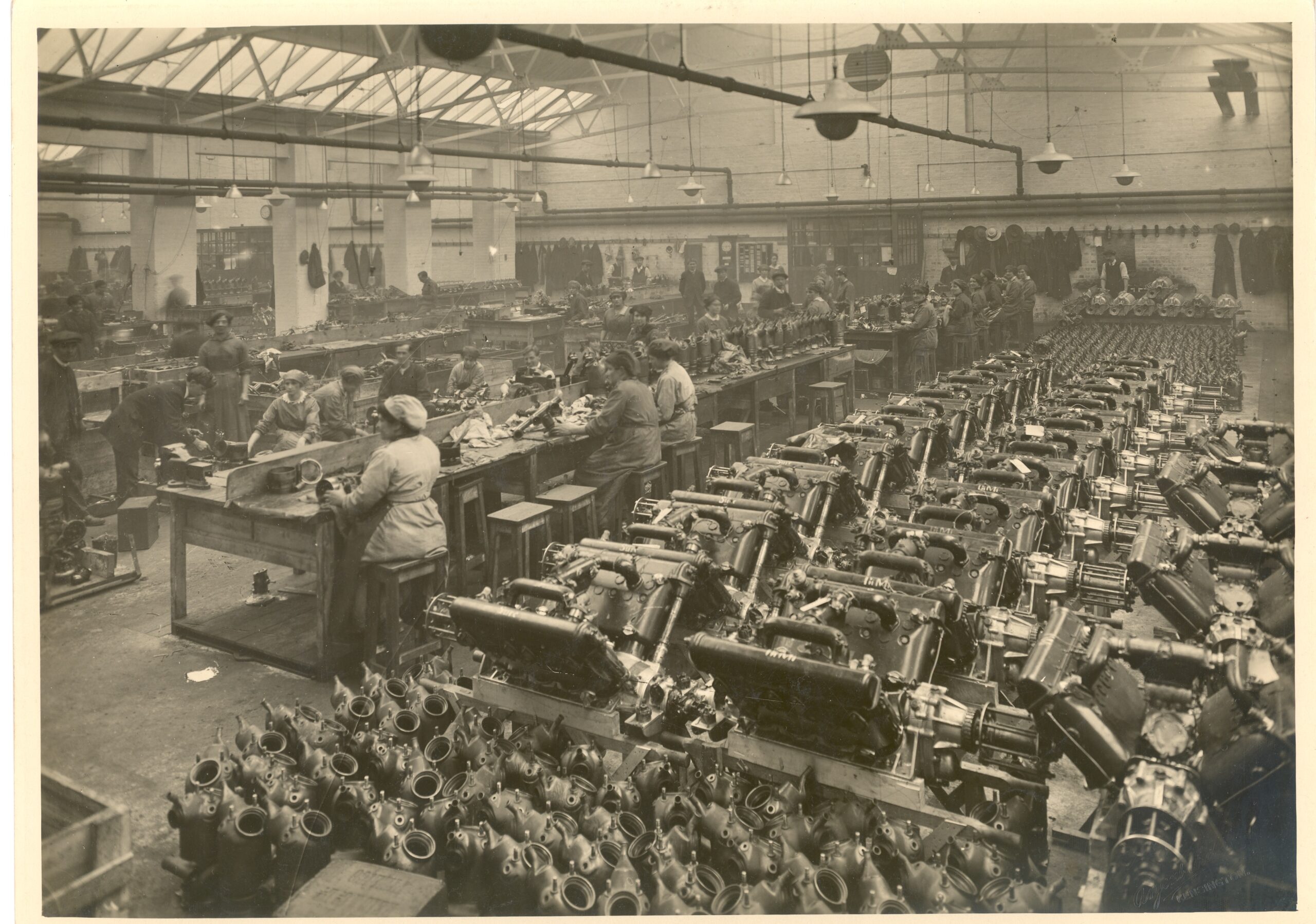 Black and white photograph showing the dismantling of Hispano Suiza aviation engines by female workers in the Gordon Watney & Co Ltd factory.
Black and white photograph showing the dismantling of Hispano Suiza aviation engines by female workers in the Gordon Watney & Co Ltd factory.
Nellie Isaac was born in 1886 to a respectable middle-class family. Before the First World War, she was living with her sister in London, working as an artist.
After the outbreak of WWI, Nellie and her sister joined the thousands of women in Britain contributing to the war effort. They gave up their art and design business and worked at the Gordon Watney & Co factory in Weybridge. They felt that this work was of national importance and Nellie captured factory life in a variety of paintings.
Many of her works can be found in the Imperial War Museum’s collections. You can find examples of her work on their Collections Webpage.
 Image of a funeral for casualties of the Air Raid at Vickers-Armstrongs Ltd, Brooklands in 1940.
Image of a funeral for casualties of the Air Raid at Vickers-Armstrongs Ltd, Brooklands in 1940.
During the Second World War, the Vickers Factory in Weybridge became a renowned manufacturer of large aircraft and landing gear. As with most factories in wartime they relied on hardworking women to continue their essential services.
On 4 September 1940, three bombs were dropped on the factory, killing 83 and injuring over 400 workers. George Roake, a Vickers sheet metal worker, remembers four young girls waving at him as they went to eat their lunch. The shelter they were in took a direct hit and little trace of them was ever found.
Although not fighting on the front line, women were risking their safety to support the ‘boys at the front’. When the country needed them, they responded in force, stepping into new roles and adapting to a new life.
Learn about Vickers on our Elmbridge At War pageIn this interview conducted in March 2020, Helen, a participant in Elmbridge Museum’s ‘Memories of War’ project, shares her memories of the impact of the German Luftwaffe’s September 1940 bombing raid on the Vickers-Armstrong aircraft factory at Brooklands.
The efforts of women throughout history have progressed the fight for equality, adult suffrage, education and career opportunities. Many of the freedoms and choices available now are a result of their passion, dedication and hard work.
 Photograph of Avril Landsdell holding up a photo donated to the museum, 1978.
Photograph of Avril Landsdell holding up a photo donated to the museum, 1978.
Avril began working at the museum as an assistant to Brian Blake in 1965. She became Head Curator at the Museum in 1968. She was a huge influence on the museum in its new home in Church Street, championing immersive learning with her historical reconstructions and interactions with school children.
Women like Avril and Ethel paved the way for the women who work at the Elmbridge Museum today. We hope to continue their work for education, history and contributing to our community’s wellbeing.
Find out about other women in Elmbridge Museum's long history hereFrom it’s headquarters at Giggs Hill in Thames Ditton and supported by a workforce of 7,000 employees spread further around the country, the Milk Marketing Board (MMB) maintained stable economic conditions for up to 70,000 independent farms.
Although agriculture was a male dominated industry, many women worked at the MMB, supporting its important work. The women in this picture are working in the busy parcels office.
Elmbridge Museum launched an online exhibition on the Milk Marketing Board in 2016 and were pleased to see the local community reminiscing about their experiences with the company. Please do share any experiences you have working here in the comments section below! We would love to hear from you.
Find out more about the MMB's history here
Curious to find out more about the history of the suffragettes?
Our Votes for Women exhibition highlights the stories of significant women from early twentieth century Elmbridge in the fight for suffrage.
Leave a comment!
We would love to hear from you and what you think of our Everyday Heroines online exhibition.This space is about celebrating women. Who are your everyday heroines, and what do they mean to you?
You need to be logged in to comment.
Go to login / register